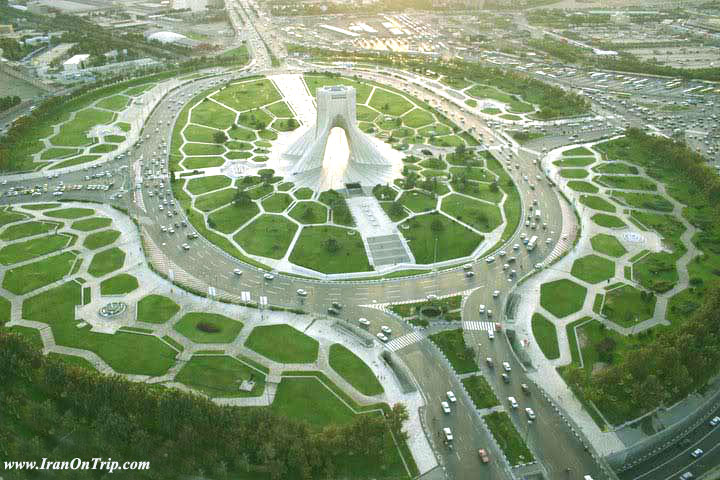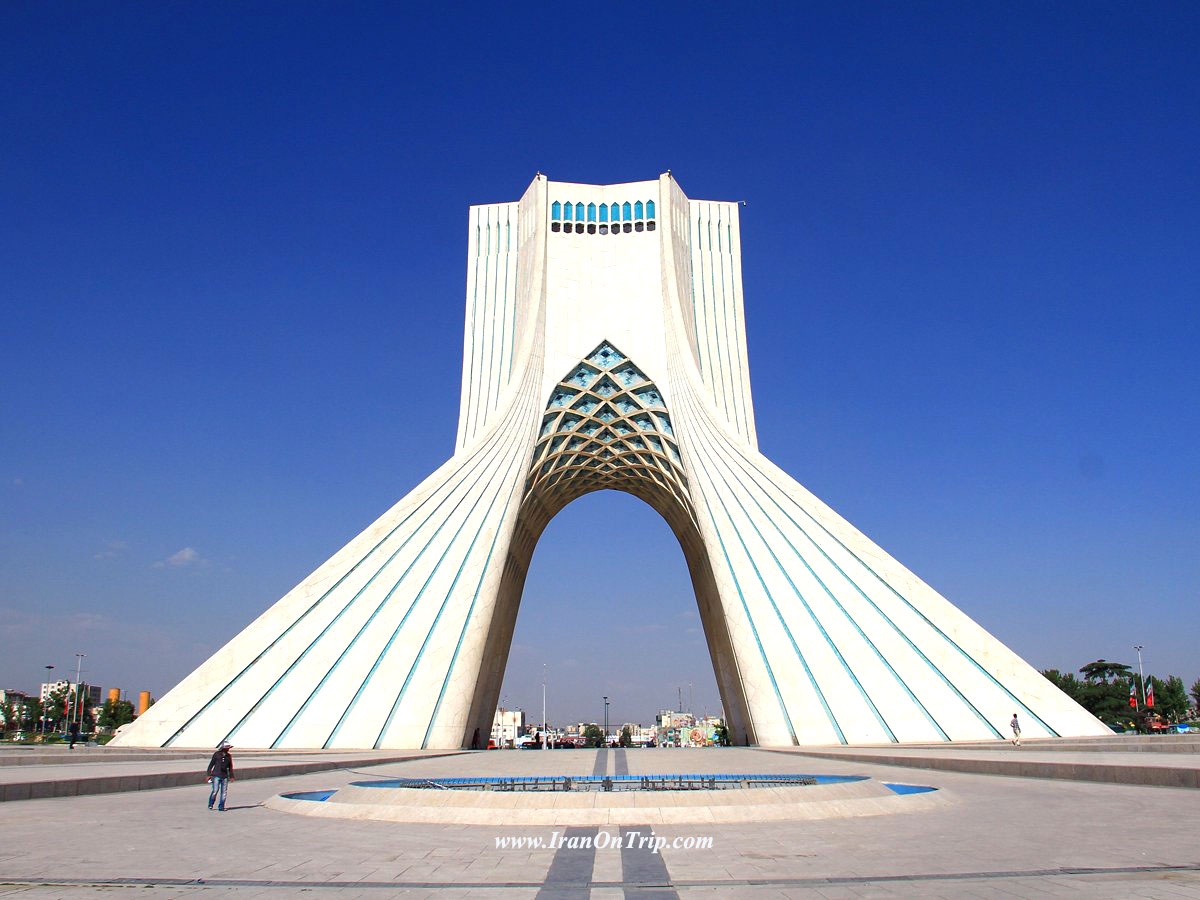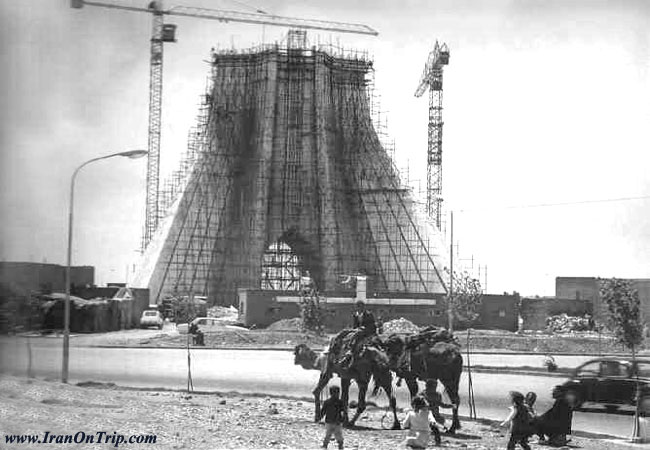Azadi Tower

Standing guard like a sentry at the gates of Tehran, Iran, is the impressive Azadi Tower (Freedom Tower), built in 1971 and comprised of eight thousand white marble blocks. A combination of both Islamic and Sassanid architectural styles, the fifty-foot high tower commemorates the formation of the Persian Empire and is an interesting combination of both modern and ancient cultures.
The tower is part of the Azadi cultural complex, located in Tehran's 50,000-square-meter Azadi square, which is made up of a museum and several fountains.
The arch rises from Azadi Square mirroring the Elburz (Alborz) mountain range just north of the city. Though not as wondrous as the snowy peaks of Mount Damavand, it is a 148 foot tall masterpiece of cut marble that marks the entrance to this historic city.
The audio - video hall of the complex which has been designed based on Iran`s geographical map displays the regional characteristics of Iran in so far as cultural, life style, religious and historical monuments are concerned. A mechanical conveyer allows the visitors to visit the hall in total comfort. Some art galleries and halls have been allocated to temporary fairs and exhibitions.

The architect, Hossein Amanat, won a competition to design the monument, which combines elements of Sassanid and Islamic architecture. It is part of the Azadi cultural complex, located in Tehran's Azadi Square in an area of some 50,000 m². There are several fountains around the base of the tower and a museum underground. The iconic Monument des Martyrs in Algiers (built, 1982) shows a strong influence by this monument, in its general design as well as its details.
Built with white marble stone from the Esfahan region, there are eight thousand blocks of stone. The stones were all located and supplied by Ghanbar Rahimi, whose knowledge of the quarries was second to none and who was known as "Soltan-e-Sang-e-Iran". The shape of each of the blocks was calculated by a computer, and programmed to include all the instructions for the building's work. The actual construction of the tower was carried out, and supervised by Iran's finest master stonemason, Ghaffar Davarpanah Varnosfaderani. The main financing was provided by a group of five hundred Iranian industrialists. The inauguration took place on October 16, 1971.

Built in 1971 in commemoration of the 2,500th anniversary of the Persian Empire, this "Gateway into Iran" was named the Shahyad Tower, meaning "Kings' Memorial", but was dubbed Azadi (Freedom) after the Iranian Revolution of 1979. Originally intended to remind coming generations of the achievements of modern Iran under the Pahlavi dynasty, it has become a symbol of the country's revival. It is 50 meters (148 ft) tall and completely clad in cut marble.
The entrance of the tower is directly underneath the main vault and leads into the Azadi Museum on the basement floor. The black walls, the pure, sober lines, and the proportions of the whole building create an intentionally austere atmosphere. Heavy doors open onto a kind of crypt where lighting is subdued. The shock is immediate. The lighting there seems to issue from the showcases placed here and there, each containing a unique object. Gold and enamel pieces, painted pottery, marble, the warm shades of the miniatures and of the varnished paintings glitter like stars among the black marble walls and in the semi-darkness of the concrete mesh which forms the ceiling of this cave of marvels. There are about fifty pieces selected from among the finest and most precious in Iran. They are in excellent condition and each represents a particular period in the country's history.
The place of honour is occupied by a copy of the Cyrus Cylinder (the original is in the British Museum). A translation of the cuneiform inscription on the cylinder is inscribed in golden letters on the wall of one of the galleries leading to the museum's audio-visual department; opposite, a similar plaque lists the Twelve Points of the White Revolution. Next to the Cyrus Cylinder, a magnificent gold plaque commemorates the presentation of the museum to the Shah by the Mayor of Tehran.
Among the earliest testimonies of Iran's history on display here are square flagstones, gold sheeting, and terra cotta tablets from Susa, covered with cuneiform characters of astonishingly rigorous geometry. Potteries, ceramics, varnished porcelains (such as the beautiful seventh-century blue and gold dish from Gorgan), an illuminated Koran, and a few exceptional miniatures highlight milestones in the country's annals up to the nineteenth century, which is itself represented by two magnificent painted panels from Farah Pahlavi's collection.
The original show, devised in 1971, was replaced in 1975 by a new one which invited visitors to discover Iran's geographic and natural diversity along with its fundamental historical elements. The landscapes and works of art, the faces and achievements, calligraphied poems and technical undertakings, the life and hopes of a population were shown through its ancient miniatures as well as through the smiling studiousness of Iran's new generation of children. This creative "Sound and Light" performance, devised by a Czechoslovakian firm, required 12,000 metres of film, 20,000 colour slides, 20 movie projectors, and 120 slide projectors. Five computers operated the entire system.
.....
.....
.....

.jpg)



























